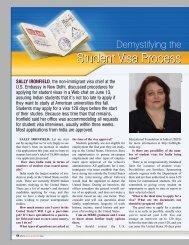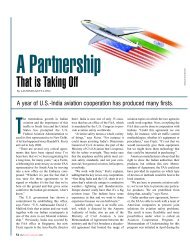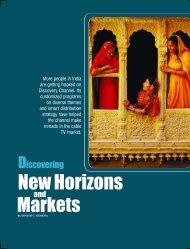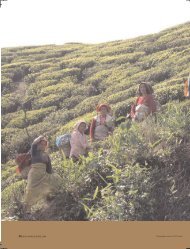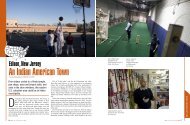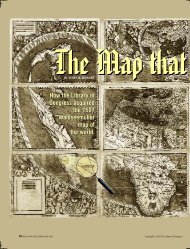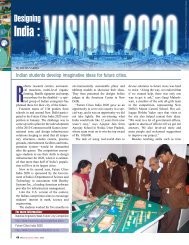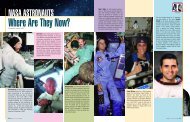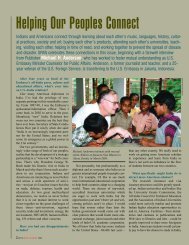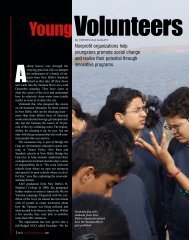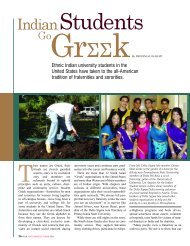Marriage Indian American Style, SPAN January/February 2008
Marriage Indian American Style, SPAN January/February 2008
Marriage Indian American Style, SPAN January/February 2008
Create successful ePaper yourself
Turn your PDF publications into a flip-book with our unique Google optimized e-Paper software.
CHRISTOPHER GLENN<br />
Valentine’s Day Tales<br />
<strong>Marriage</strong><br />
<strong>Indian</strong> <strong>American</strong> <strong>Style</strong><br />
The array of choices, the coping<br />
strategies of mixed couples is<br />
exciting and a bit hilarious.<br />
40 <strong>SPAN</strong> JANUARY/FEBRUARY <strong>2008</strong><br />
Peter and Heather Malakar<br />
Couple No. 1<br />
By ANNE LEE SESHADRI<br />
That day” is around the corner again,<br />
the day that rekindles memories of<br />
love and intimacy, and precious<br />
moments stolen on moonlit balconies<br />
or beaches. For my husband<br />
and me, as well as the thousands of couples<br />
in the United States and India who confounded<br />
parental expectations, rolled the<br />
proverbial dice and married someone ethnically<br />
distinct from across the oceans,<br />
Valentine’s Day represents the triumph of<br />
love over arranged, of Cupid over karma.<br />
Meeting on an <strong>American</strong> University campus,<br />
as Srikanth and I did 10 years ago, we<br />
knew that by tying the knot and circling the<br />
fire, we’d be taking Robert Frost’s “Road<br />
Less Traveled.” Little did we know, however,<br />
what excitement lay in store as two cultures<br />
collided and coalesced to direct our<br />
day-to-day <strong>American</strong>, and now <strong>Indian</strong>, life.<br />
In both Washington, D.C. and New Delhi,<br />
I happily realized that we were not alone in<br />
this experiment. Seeing <strong>American</strong> and<br />
<strong>Indian</strong> couples all around me, I found the<br />
array of choices, the coping strategies of us<br />
mixed couples exciting and a bit hilarious as<br />
well. Truth, myth or fun? I resolved to find<br />
out, and several brave couples obliged me<br />
with their special Bride & Prejudice, happily-ever-after<br />
stories.<br />
How They Met<br />
(Or as Kareena Kapoor once said: Jab<br />
We Met)<br />
In class, through friends, in chat rooms—
Courtesy MONI DUFFY<br />
Kevin and Moni Duffy<br />
Couple No. 2<br />
today’s <strong>Indian</strong> <strong>American</strong> couples meet typically<br />
and fatefully, even when a love match<br />
was not what they or their parents had in<br />
mind.<br />
Couple No. 1: When Los Angeles native<br />
Heather Halstead, who has a Master’s<br />
degree in counseling, was exploring northeastern<br />
India to find opportunities for serving<br />
people, she met Peter Malakar, a<br />
Christian <strong>Indian</strong> doctor. But romance was<br />
the furthest thing from her mind. Having<br />
earlier experienced life and customs in a<br />
remote, conservative <strong>Indian</strong> village, she<br />
was ultra-cautious. “He would e-mail me<br />
(when I returned to California) but I wouldn’t<br />
respond for several months, just so that<br />
he wouldn’t get the wrong idea,” says<br />
Heather. The persistent doctor had the right<br />
idea all along: He kept praying. Heather<br />
returned to India, this time to New Delhi,<br />
where Peter was working. And seeing that<br />
they were better together than apart, they<br />
fell in love, got married in December, 2005<br />
in California, and returned to New Delhi,<br />
where they now run an NGO together.<br />
Couple No. 2: For them, it was an easier<br />
choice. “My father told me he would never<br />
push me into marriage,” says Moni Basu, a<br />
Bengali non-resident <strong>Indian</strong> whose family<br />
emigrated to the United States when she<br />
was 13. She met Kevin Duffy, a fellow<br />
reporter, while they were working the night<br />
beat at the Atlanta Journal-Constitution in<br />
the southern U.S. state of Georgia.<br />
Courtesy ARIANA RABINDRANATH<br />
Sunil and Ariana Rabindranath<br />
Couple No. 3<br />
Couple No. 3: Student Sunil Rabindranath,<br />
of South <strong>Indian</strong>-Malaysian origin, found<br />
student Ariana Leon, a Midwestern<br />
<strong>American</strong> with a keen interest in South and<br />
Southeast Asia, through mutual friends.<br />
They attended graduate school together<br />
at Ohio University and now live in<br />
Washington, D.C.<br />
Couple No. 4: Anshul Kaul, a Kashmiri,<br />
and Jenika Doctor, who now coordinates<br />
the South Asian Studies Program at Johns<br />
Hopkins University’s School of Advanced<br />
International Studies in Washington, D.C.,<br />
crossed paths in India while she was an<br />
intern. He Hindu, she Jewish and Unitarian,<br />
they now live in the Washington, D.C. area,<br />
are married and looking forward to their<br />
first-born.<br />
Couple No. 5: Dominic Keating was a<br />
lawyer in San Diego, in California, when<br />
he stumbled across and fell in love with<br />
Shaista Taj, an Accenture consultant, on a<br />
jogging trail. Shaista’s Muslim parents<br />
were helping her find a proper husband…but<br />
“son-in-law Dominic” was a<br />
real Pyar Mein Twist.<br />
Meet the Parents<br />
(Do you want my daughter’s hand?)<br />
Meeting one’s prospective in-laws is<br />
daunting in any culture, but doubly so<br />
when you’re dealing with foreign elders. In<br />
some instances, it’s the mom who requires<br />
gentle persuasion. The first time Anshul<br />
visited Jenika’s parents in the United<br />
KEN DOCTOR<br />
Anshul and Jenika Kaul<br />
Couple No. 4<br />
States, her mom was concerned and a bit<br />
worried. Why wasn’t he holding her hand<br />
or showing any affection? Did he really<br />
care for her? Little did she understand that<br />
to Anshul, public displays of affection were<br />
highly inappropriate, and especially embarrassing<br />
considering the “public” included<br />
his future-mother-in-law.<br />
<strong>American</strong> dads aren’t necessarily any<br />
easier. Heather’s father flew to India from<br />
California to check out Peter before the couple<br />
were engaged. Peter won over his future<br />
father-in-law quite quickly (as Mr. Halstead<br />
was nothing like the tough and rough<br />
Robert De Niro of Meet the Parents) and<br />
the engagement ceremony was full of<br />
<strong>Indian</strong> culture and color. But Heather also<br />
wanted an <strong>American</strong>-style engagement.<br />
With advice from her <strong>American</strong> roommate,<br />
Peter planned a romantic day (or so he<br />
thought) boating on a lake outside New<br />
Delhi—only to discover that the water had<br />
dried up several years before, leaving only<br />
cows lazily grazing on the lake bed. Not to<br />
be deterred, Peter ordered a cup of hot tea,<br />
bent down on his knee, and beseeched<br />
Heather for her hand.<br />
DAY<br />
Dominic also had to deal with a tough,<br />
prospective dad-in-law. “When I walked<br />
into the room to talk with her father for<br />
the first time,” Dominic recalls, “he seated<br />
himself in a corner of the room with his<br />
arms folded.” Shaista excitedly interrupts,<br />
“But when I returned from the kitchen an<br />
hour later, they were sitting near each VALENTINE’S<br />
<strong>SPAN</strong> JANUARY/FEBRUARY <strong>2008</strong> 41
Courtesy DOMINIC KEATING<br />
other and my father’s arms were stretched<br />
across the back of the couch.” This didn’t<br />
surprise her: “My father and Dominic are<br />
very alike…They find common ground in<br />
law, science, current events.” That’s not to<br />
say Dominic was off the hook when it<br />
came time for the Muslim custom of asking<br />
the bride’s father for permission. In a<br />
scene out of some <strong>American</strong> talk show,<br />
Dominic had to ask for Shaista’s hand in<br />
front of a big audience: her father was<br />
there, as well as Shaista’s entire paternal<br />
family.<br />
42 <strong>SPAN</strong> JANUARY/FEBRUARY <strong>2008</strong><br />
Dominic and Shaista Keating<br />
Couple No. 5<br />
I Do—But How?<br />
(And what color is my sherwani?)<br />
Creativity and negotiation are needed in<br />
planning <strong>Indian</strong> <strong>American</strong> weddings. Our<br />
five couples adopted differing approaches<br />
to satisfy the expectations of both sides.<br />
Sunil and Ariana participated in two separate<br />
ceremonies, but integrated one another’s<br />
customs in both. His family sent Hindu<br />
symbols and wall hangings to adorn the<br />
front of the church for the <strong>American</strong> ceremony.<br />
He dutifully donned his first-ever<br />
tuxedo for the occasion and she wore a pur-<br />
ple sari instead of a traditional <strong>American</strong>,<br />
white, wedding dress. For the Hindu<br />
engagement, Ariana wore a Malayali-style<br />
sari and touched the feet of Sunil’s mother<br />
and grandmother, receiving their blessings.<br />
For Jenika and Anshul, who choreographed<br />
and participated in a “big, fat” fiveday<br />
<strong>Indian</strong> extravaganza, the <strong>American</strong><br />
wedding part incorporated both cultures,<br />
including a canopy that represented a<br />
Jewish huppah and Hindu mandap, poems<br />
by Rabindranath Tagore and the perennial<br />
favorite, Punjabi bhangra at the reception.<br />
Shaista and Dominic planned a<br />
Western-style wedding at a hotel in<br />
California. Only when they walked up<br />
the aisle, a Muslim imam was there to<br />
greet them instead of a minister or priest.<br />
Then they signed a traditional Islamic<br />
marriage contract. She wore an <strong>Indian</strong><br />
wedding dress, but in white, the color<br />
most <strong>American</strong> brides wear, instead of<br />
red. Dominic’s family joined in the<br />
henna ceremony, with both sides singing<br />
songs in English and Urdu, praising or<br />
deprecating the bride and groom on cue.<br />
Dominic’s family seemed to take the<br />
upper hand in the mock competition, but<br />
few recalled the score afterwards, for it<br />
was all in good fun.<br />
Heather and Peter tied the knot in multiethnic<br />
Los Angeles, and enjoyed adding all<br />
the <strong>Indian</strong> touches and flourishes they could<br />
find. Her bridesmaids wore lehengas tailormade<br />
in New Delhi based on e-mailed<br />
measurements, and a woman acquaintance<br />
originally from Hyderabad prepared all the<br />
mouth-watering food. The most moving<br />
part of the ceremony came during a short,<br />
simple phone call, when Peter dialed his<br />
parents on their landline in Assam. With a<br />
microphone held to the receiver for all to<br />
hear, Peter’s parents prayed for God’s blessings<br />
on the marriage from halfway around<br />
the world.<br />
The Quickest Way to Your In-Laws’<br />
Hearts (Through their stomachs, of<br />
course.)<br />
<strong>American</strong>s married to <strong>Indian</strong>s quickly<br />
learn the importance of food in their partner’s<br />
culture. In fact, eating skills seem to be an<br />
avenue of acceptance into the new family.<br />
Kevin was astounded the first time he<br />
visited his in-laws in West Bengal. As a<br />
mark of respect, he was presented with a silver<br />
plate holding 22 types of food. “Where
do I even start?” he wondered. Since that<br />
awkward first encounter with <strong>Indian</strong> cuisine<br />
and overwhelming hospitality, however,<br />
he has proven himself to be a good desi<br />
by learning to eat Bengali fish dishes with<br />
his hands. “He can sail though the tricky<br />
fish dishes,” says Moni with admiration,<br />
“even the bony elish fish.”<br />
Like Kevin, Dominic also mastered the<br />
<strong>Indian</strong> art of eating without utensils.<br />
Shaista states proudly, “He does<br />
really well; instead of looking<br />
around for a hot dog and ketchup,<br />
he asks for pickle.”<br />
Biryani, kebabs, fish and<br />
masala dosa—-these are some of<br />
the <strong>American</strong>s’ favorite dishes,<br />
covering the north, south, east and<br />
west of <strong>Indian</strong> culinary culture. With<br />
practice, Ariana has become quite an<br />
<strong>Indian</strong> cook herself. “She used to measure<br />
out everything with great pains when<br />
she cooked Kerala dishes,” Sunil explained,<br />
“but now a pinch and a smidgen have<br />
become valid measuring units for her.”<br />
Cultural Blunders<br />
(A Fashion Faux Pas)<br />
Navigating <strong>Indian</strong> culture can be tricky, say<br />
the <strong>American</strong> spouses, even after studying<br />
it for many years. Sometimes the<br />
<strong>American</strong>s try too hard and err on the side<br />
of excess. When gallant, suave Sunil tied<br />
Ariana’s first sari on her, he miscalculated<br />
with some of the pins and left half of her top<br />
exposed.<br />
Sometimes these well-meaning spouses<br />
do get it right. While Dominic dances the<br />
bhangra well, Kevin is called a movie star<br />
when he dons <strong>Indian</strong> dress. And Ariana,<br />
after the initial botched attempt, is more<br />
comfortable and relaxed wearing a sari<br />
than a Western style dress, says Sunil.<br />
Baby X (And how to keep nosy<br />
neighbors guessing.)<br />
For most <strong>American</strong>s, picking a child’s<br />
name is easy because it’s a parent’s individual<br />
choice. But in mixed marriages,<br />
naming babies is half graceful art, half<br />
political compromise and no longer about<br />
advertising to the world which state, city,<br />
religion, ethnicity, class, caste, author,<br />
actor or relative the parents most identify<br />
with.<br />
For Shaista and Dominic, it was important<br />
to give their children global names, not<br />
just bicultural ones. Summer (Samar) is an<br />
Arabic name that is understood everywhere,<br />
they explained, while Sophia can be<br />
<strong>Indian</strong>, Pakistani, European or <strong>American</strong>.<br />
Holidays: Twice the Usual Fun<br />
<strong>Indian</strong> <strong>American</strong> couples tend to have<br />
double the fun when it comes to celebrating<br />
holiday traditions. “We celebrate every-<br />
VALENTINE’S DAY<br />
Contrary to popular belief, Valentine’s Day is not an <strong>American</strong> invention.<br />
The customs of exchanging romantic cards, giving flowers or sweets<br />
or taking time to express tender sentiments to one’s significant<br />
other on <strong>February</strong> 14 developed in Europe and were brought to<br />
the United States by immigrants. It is not a holiday anywhere<br />
in the United States. But woe betide any hus-<br />
Courtesy ANNE LEE SESHADRI<br />
band or boyfriend who manages to forget the<br />
day in the face of all the advertising<br />
by greeting card and candy<br />
makers, restaurants and<br />
hotels, florists and<br />
gift stores.<br />
thing!” proclaim<br />
Dominic and Shaista,<br />
pointing out that, for them,<br />
marking Eid and Christmas every<br />
year is a way to teach their children to be<br />
tolerant and free from prejudice.<br />
Ariana and Sunil made their annual<br />
Diwali party a tradition at their Northern<br />
Virginia home. Moni and Kevin celebrate<br />
Durga Puja in Atlanta, Georgia, while<br />
Anshul and Jenika enjoy celebrating<br />
Christmas, Holi and Hanukkah.<br />
Most mixed couples celebrate Christmas.<br />
“Although Christian, Peter was not used to<br />
seeing a Christmas tree,” Heather<br />
explained, “but he is patient with my<br />
<strong>American</strong> customs.” Sometimes it’s the<br />
other way around. Moni recalls her first<br />
Christmas with Kevin, “I grew up (as an<br />
<strong>Indian</strong> in America) longing to celebrate<br />
Christmas. So Kevin did all the traditional<br />
things for me that one would do for a child,<br />
from buying and decorating a tree, to giftwrapping<br />
presents—everything except<br />
Santa Claus!”<br />
Jenika makes sure that Anshul gets his<br />
own stocking and a Christmas<br />
ornament every year, along with a<br />
traditional lamb dinner that sits<br />
well with his Kashmiri heritage.<br />
Three Cheers for the Ties that<br />
Bind (And the love that<br />
endures.)<br />
When asked what they appreciate<br />
most about their spouses’ <strong>Indian</strong> culture,<br />
the <strong>American</strong>s I interviewed were<br />
unanimous: their strong sense of family.<br />
“The extended family is very strong,<br />
the togetherness,” says Dominic, whose<br />
in-laws reside with him.<br />
Moni observes: “In India, the house is<br />
open to everyone in the family.” Kevin<br />
understands the importance of family and<br />
enjoys the “family ties I have.”<br />
For all young couples, marriage to<br />
someone from another culture was as<br />
interesting as it was illuminating. And as<br />
the years go by, do the differences diminish?<br />
To answer that I had to find a couple<br />
whose marriage had withstood the test of<br />
time and distance. I found my inspiration<br />
in Ophelia and Amos Gona, she an African<br />
<strong>American</strong> professor from the southern<br />
United States, he a professor from Goa,<br />
both living in suburban New Jersey since<br />
the 1970s and now retired. When I asked<br />
Ophelia what insights she could share with<br />
<strong>SPAN</strong> readers about bridging cultural differences,<br />
she wrote: “It sounds strange, but<br />
after 46 years of marriage, I can’t think of<br />
anything I could possibly add.” I went<br />
back home and told Srikanth, and we both<br />
smiled.<br />
Anne Lee Seshadri, at left in her wedding<br />
photo with her husband, Srikanth, is an assistant<br />
cultural affairs officer at the U.S. Embassy<br />
in New Delhi.<br />
Adnan Siddiqi, the cultural affairs counselor<br />
at the U.S. Embassy, contributed to this article.<br />
Please share your views on this article. Write to<br />
editorspan@state.gov




